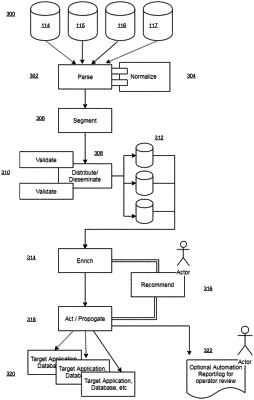| CPC H04L 67/5651 (2022.05) [G06F 8/453 (2013.01); G06N 5/04 (2013.01); H04L 67/01 (2022.05); H04L 47/2416 (2013.01); H04L 2012/5621 (2013.01)] | 1 Claim |

|
1. A cognitive automation-based method propagating data across multiple systems via a private network to avoid repetitive data entry by a user, the method comprising the steps of:
receiving, by a cognitive automation platform from a data source, input source data;
storing, by the cognitive automation platform in a first sector of computer-readable media, the input source data;
extracting, by the cognitive automation platform from the input source data in the first sector of the computer-readable media, data to be propagated;
storing, by the cognitive automation platform in a second sector of the computer-readable media, the data to be propagated;
parsing, by the cognitive automation platform, the data to be propagated into parsed data;
storing, by the cognitive automation platform in a third sector of the computer-readable media, the parsed data;
normalizing, by the cognitive automation platform, the parsed data into normalized data for efficient processing, said normalized data normalized into at least a first normal form;
storing, by the cognitive automation platform in a fourth sector of the computer-readable media, the normalized data;
segmenting, by the cognitive automation platform, the normalized data into segmented data by breaking the normalized data into a plurality of smaller packets for efficient data transmission;
storing, by the cognitive automation platform in a fifth sector of the computer-readable media, the segmented data;
validating, by the cognitive automation platform, the segmented data into validated data to ensure that the validated data satisfies defined formats and input criteria;
storing, by the cognitive automation platform in a sixth sector of the computer-readable media, the validated data; and
distributing, by the cognitive automation platform over the private network, the validated data into a plurality of data stores communicatively coupled to the private network, thereby propagating said validated data without repetitive data entry.
|